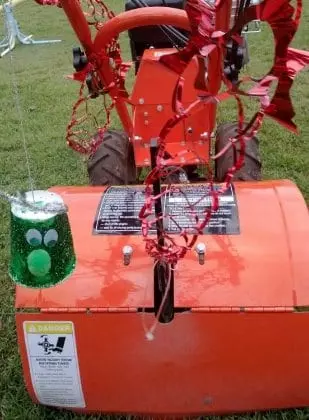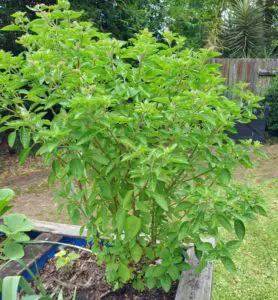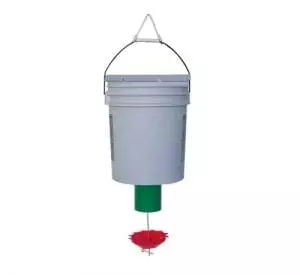Introduction
(This article was reviewed in July 2012) Tiller the Season to be Growing Trul-a-lul-a-la blah blah blah blah… I know the title is drawing a long bow for a Christmas theme but I've never been a very orthodox person and I guess if you have been following my articles over the past 6 months you'll know that I'm a pretty unorthodox writer anyway.
It’s a beautiful white winter Xmas across the other side of the world and in South-East Queensland, Australia, the summer rains have begun and it's more humid here than a sumo wrestlers jockstrap. Christmas is a good time to get the family together and share the news about the year gone and the year beholding and that’s all nice; however, the real joy is a break from work and a chance to get doing some of those hobbies and activities one has put on the back burner throughout the year – like gardening!
 More specifically, the veggie patch and if you need to make it from scratch sometimes the easiest and cheapest way to create a growing space is by digging up a spare patch of dirt or grass. Really, if you do have a large expanse of lawn that you use for walking on, looking at, and looking at some more, I strongly urge you to turn some of that expanse into a food garden. Vegetable patches and fruit trees are much more productive than turf and they look great too.
More specifically, the veggie patch and if you need to make it from scratch sometimes the easiest and cheapest way to create a growing space is by digging up a spare patch of dirt or grass. Really, if you do have a large expanse of lawn that you use for walking on, looking at, and looking at some more, I strongly urge you to turn some of that expanse into a food garden. Vegetable patches and fruit trees are much more productive than turf and they look great too.
But turning that patch of lawn into a veggie patch can be hard work with hours of hoeing, forking, and shovelling so that's why the tiller (also known as a cultivator or rotary hoe) was invented. Of course farmers have been using this artificial method of turning the soil for centuries, pulling ploughs behind animals and giant machines. Now days, any backyard gardener can have a mechanical tiller to assist in their garden no matter what size and save themselves hours of hard slaving in the sun. Who wants to spend hours digging when it makes sense to prepare the ground as quickly as possible and get straight to the fun parts of gardening (planting and growing).
What is a hand tiller and why use one?
 A tiller or rotary hoe or cultivator is a petrol powered mechanical device used in the garden to loosen and turn the soil usually in preparation for new plantings. The once hard compacted ground can be tamed becoming crumbly aerated rich soil. Then, furrows can be created to allow good drainage for root systems in an easy growing medium giving plants the maximum chance to flourish.
A tiller or rotary hoe or cultivator is a petrol powered mechanical device used in the garden to loosen and turn the soil usually in preparation for new plantings. The once hard compacted ground can be tamed becoming crumbly aerated rich soil. Then, furrows can be created to allow good drainage for root systems in an easy growing medium giving plants the maximum chance to flourish.
Overtime, gardens (particularly food gardens) do get compacted through weather and being trodden in/on and this can make it difficult for plants to set root through this hard soil. Survival for the plant becomes difficult due to the soils lack of oxygen (or anaerobic qualities) making it hard to seek and take up much needed nutrients for good growth and fruit production.
Preparing the ground before planting is therefore vital for good results, in particular, for food crops grown over a relatively short period of time. A tiller/rotary hoe can turn and loosen the soil better than a shovel and fork much like mixing a cake in a bowl with an electric whisk is better than a spoon by hand.
Cultivating the soil may not be a problem if you have a small area or raised garden beds; however, if your growing area is medium to large and traditional then digging by hand with a hoe, shovel, and fork can be back breaking work and seem to take an eternity.
A tiller/rotary hoe can help turn a tedious task into a not so tedious task by mechanising the job and reducing time and effort.
What to look for in a home tiller?
Walk into your local hardware or gardening centre and you'll be spoilt for choice these days by the array of small motor machines on offer. It's amazing how many different types of motorised garden gadgets there are to assist in the garden! There are also many different types of tillers and they're not all the same (actually, some are complete rubbish) so below are some things to consider if you're looking to buy one:
-
Size – The size of the tiller you should buy must be relative to the garden and soil you have as follows:
-
Garden size – if your patch is only a few metres square then using a small 1.5 Hp tiller should do the job (power wise) easily enough providing the soil is ok (more about soil below). Also, in a small area you don't want a large machine with big wheels as turning and changing direction in a small space could be problematic. Likewise, a large area to be cultivated would obviously be faster with a wider tiller base (500-700mm) otherwise you'll be walking behind your machine all day using a tiller only 24cm wide.
-
Soil – Is your soil hard as buggery or soft and sandy? It's important to understand your soil type as the purchase of a tiller can really go wrong in this area and lead to great disappointment. An undersized, underpowered tiller will just skip across the surface of a hard clay-based or rocky compressed patch of dirt and hardly not dig at all. Even worse, the forcing downwards to compensate and make it dig may lead to damaged tines, broken hubs, snapped gear shaft etc, or even injury! Wet clay will just stick to the undercarriage of the machine and clog the tines rendering an inferior tiller useless, whereas, a more powerful tiller (say 6.5 Hp or more) can keep turning and throwing the clay/heavy soil out. The opposite can be said for light sandy or already well cultivated soils where a smaller or less powerful tiller/rotary hoe could save considerable cost, be easier to manoeuvre, and do as good of a job as a large expensive more powerful machine but you must know your soil qualities first before deciding.
-
-
Motor – Many of these tillers/rotary hoes come with similar designs and exteriors; however, it's inside that makes all the difference and the motor obviously is important. Cheaper
 “no-name” motors are very common these days and some are rather good but many are pretty lousy. These machines are placed under incredible stress for long operating periods and whilst the cheaper motors will do the job for awhile it's prudent to get a machine with a good brand name. These companies protect their reputation by constantly reviewing, testing, and upgrading their products with warranties and claims usually well managed. Plus, you're buying a tiller to do a tough job and you deserve confidence in the make that it will do the task as advertised – the last thing you want is to waste time replacing machinery or chasing a warranty claim through a company on the other side of the world with support staff who don't care.
“no-name” motors are very common these days and some are rather good but many are pretty lousy. These machines are placed under incredible stress for long operating periods and whilst the cheaper motors will do the job for awhile it's prudent to get a machine with a good brand name. These companies protect their reputation by constantly reviewing, testing, and upgrading their products with warranties and claims usually well managed. Plus, you're buying a tiller to do a tough job and you deserve confidence in the make that it will do the task as advertised – the last thing you want is to waste time replacing machinery or chasing a warranty claim through a company on the other side of the world with support staff who don't care. -
Reputable retailer – As outlined above, except for, I guess there's no problem with trying one of those “no-name” brands of tillers/rotary hoes as long as you get them from a retailer with a fair exchange or money back policy. You'll get your money back if the tiller breaks or doesn't live up to expectations; it may be a bit of a stuff around but at least your covered. At the end of the day, flexibility and peace of mind is what a good retailer gives so I'd stick with a retailer you know or one with excellent reviews (especially if you are trying a brand that isn't very well known).
-
Cost and quality – I've heard of people buying cheap chainsaws that last about 18 months before they throw it and buy another. They swear this method is cheaper in the long run compared with buying an expensive brand. Each to their own, although, I tend to take the view cheaper in most cases means inferior parts, which logically must affect performance – I would think. Performance is especially true for tillers. I've even had a conversation with a sales person at a popular hardware store where he has discreetly discouraged me from buying any of their several tillers saying the warranty returns for them are high due to breakdown and poor results – now that's what I call standing behind the product you sell from a proper hardware store. If you want my advice, go for a quality brand product but research and seek the best possible price because prices fluctuate greatly in tillers/rotary hoes.
Other important points when considering a tiller/cultivator/rotary hoe
Expectations – Hand held tillers are simply not powerful enough to work the soil like a tractor can – they can't be or it'd tear our arms off trying to control it. Therefore, there are limitations as to how effective the machinery can work the soil. Operated correctly, hand controlled tillers/rotary hoes can save lots of time in the garden but don't hold your expectations too high and expect this machine to work perfectly like the brochure. You simply just can't walk behind a tiller and expect perfect 12 inch furrows in your wake – no way.
Effort required – Tillers/rotary hoes still take effort to use so don't be under any false illusion that by having a tiller it'll be like pushing a lawn mower – it's NOT. Tillers (especially the larger 5 Hp plus machines) require quite a bit of upper-body strength to control the machine and if you are not careful these machines can easily get out of control. 
Re-do – Often the garden area being cultivated requires more than one pass (sometimes several) to work the soil to the depth required. Most tillers/rotary hoes have a depth regulator leaver (pictured right) and depending on how deep you want to go and the type of soil you have you may need to start on shallow and edge your way deeper on each run as the soil loosens. So, be prepared to still spend some time digging the soil although pick and shovel is still harder (I reckon).
Fuel – Fuel type can be an irritant for some… well it is for me. Mixing fuel with oil to produce 2-stroke fuel annoys me so I like small engines that use 4 stroke fuel; that is, unleaded fuel straight from the bowser – no mixing no fuss. That means less can go wrong with fuel contamination or confusion, but just remember small engines using 4 stroke need oil so the separate oil compartment will have to be monitored and topped up with oil occasionally.
Safety – Read the user manual and use the tiller/rotary hoe strictly as the manual direct s. Most tillers are self propelled (SP) and like any SP equipment it makes the job easier physically but it also increases the risk of injury or damage through losing control. I'm sure I don't need to explain what damage spinning tines can do to hands, and legs on a human.
s. Most tillers are self propelled (SP) and like any SP equipment it makes the job easier physically but it also increases the risk of injury or damage through losing control. I'm sure I don't need to explain what damage spinning tines can do to hands, and legs on a human.
Also, most larger tillers have the ability to make pushing it into position easier by removing the hub pins (left) on the wheels (essentially unlocking the hubs) and whilst unlocked hubs makes it easier to move the tiller, it should only be done when the machine is off and then the hubs must be locked again prior to starting the machine. It is dangerous to use a large tiller if the hubs are “free wheeling” whilst the machine is operating because it's the wheels that operate as the “brakes” and to be effective they need to be locked into the driving gear of the tiller.
Do you need a tiller?
This depends on several things:
-
Your determination – If you don't mind digging and you have the time to spare then a tiller may be just a waste of money because it's not like a mower that's used regularly. And, if you're prepared to mostly hand dig your patch for exercise or more control, having a tiller on the odd occasion for when you don't feel like digging seems to be an unnecessary luxury purchase for the person who has it all in the shed. On the other hand, if you do spend a great deal of time in the garden and deplore “cultivation time” as a necessary chore you wish could be done faster (or by someone else), then buying a tiller/rotary hoe will definitely free you up to have more time planting and fiddling in the garden instead of digging.
-
Soil relative to size

– Basically, how hard is the soil to dig compared to how much area there is to dig. A 10 or 20 metre square garden is a hell of an area to dig by hand, for example. Even worse if the soil is compacted and set with heavy clay. A heavy garden like this could take weeks of digging by hand to finish the job. Alternatively, A tiller could have the weeds and grass dug in and soil aerated in one day. However, a large sandy area or loose soil can be dug rather quickly and if digging is “easy going” then a tiller would get the job done quickly but against cost it just may not be economical and you might be better off hand digging for just that few extra hours a tiller may save.
-
Your budget – Having a tiller is not an essential piece of machinery (like a post hole digger for a small acreage) it's nice to have but just the same if you don't have the money to spend you can still do the job manually by hand with garden tools. Don't forget you can hire tillers/rotary hoes for those one-off times when you just want to get a bed started and then once the soil is loose you can turn it by hand in the future.
-
Your thinking – There are lines of thinking in modern gardening circles that are leaning towards minimal soil disturbance rather than turning the heck out of it. The reasoning behind minimal soil disturbance is the belief that by over tilling the soil you upset the natural nutrient balance and also disturb or kill good bacteria and animals (like worms), which benefit the soil greatly. I can understand the minimal soil disturbance way of thinking actually, but I'm not sure the theory is proven. However, if you do lean towards this way of thinking a tiller might not be for you.
 What have I got?
What have I got?
After much research on price, quality, retailer and what I needed for my yard, I ended up buying a 4 stroke Briggs & Stratton 6.5HP Cultivator Tiller from a reputable company online through eBay (pictured right). I also have made a YouTube video of this tiller in use check it out here.
Below are the features and specifications straight from their website:
Features of the 6.5HP Briggs & Stratton Power Unit
-
synchronous-rotating tines for easy use and greater control
-
Forward and Reverse
-
Quality Heavy Duty Construction
-
Heavy duty gear box
-
Sealed Transmission,eliminating maintenance
-
Height adjustable Tilling Depth up to 350mm
-
12" tyres for easier manoeuvrability
-
4 Litre tank capacity continuous use
-
Powder Coated Finish
-
Anti-vibration Design
Specifications – Engine Type: Briggs & Stratton Vanguard
-
Displacement: 206cc
-
Power Output: 6.5hp/4.7kW
-
Fuel Capacity: 4.0L
-
Oil Capacity: 0.7L
-
Bore/Stroke: 6.83cm / 5.59cm
-
Transmission: Forward / Reverse
-
Tyre Size: 12”
-
Tilling Width: 500mm
-
Tilling Depth: Up to 350mm
-
Dimensions (L x W x H): 140cmx48cmx60cm
-
Weight: 73N.W 80G.W
Assembly
I found assembly upon arrival (via courier) was minimal as it was practically all done, including oil, and professionally packaged.
Price
I priced similar models to mine with exactly the same specifications and quality in the shops (and also online) and some were selling for over double the price! As mentioned, I bought mine through eBay because at the time the retailer were selling this type of tiller cheaper on eBay than on their actual website so it pays to check if a company is selling the same item through another means and for a cheaper price (check freight costs as they fluctuate also).
$699 AU is what I ended up paying for mine and that included the delivery price and GST. I priced the exact same unit (brandishing a few different stickers and coloured paint job) at a competitors shop for $1399 so I was wrapped to make such a savings.
Performance
The tiller I have has plenty of might and is amazingly powerful for its size.
Truthfully, it took me about 30 minutes to get used to operating it and setting the depth correctly in order to stop me from having to jog behind this beast of a machine or get thrown around lurching forwards violently.
 I really have given it a flogging and worked its guts out through clay and heavy compacted soil (see pictures) and it has done me proud but more importantly it has felt strong, hasn't clogged up with mud, and it's purred along reliably as I expected it should do. The patch shown as tilled in the pictures started as full grass the same as the surroundings and as you can see it sure churned it up.
I really have given it a flogging and worked its guts out through clay and heavy compacted soil (see pictures) and it has done me proud but more importantly it has felt strong, hasn't clogged up with mud, and it's purred along reliably as I expected it should do. The patch shown as tilled in the pictures started as full grass the same as the surroundings and as you can see it sure churned it up.
I threw down a few large bags of gypsum to help break the clay and some fertiliser before tilling so it could all be mixed in together at the same time.
Overall, I've been very happy with the purchase of the tiller/rotary hoe. After using this machine for 12 months now I've yet to have a warranty issue or even a splutter from the engine but if something should go wrong I'm pretty satisfied I'll be looked after by the retailer. I guess I can say I feel I got value for my money.
Conclusion
To till or not to till? Only one's own circumstances and favour can determine that question. Nevertheless, if you are considering buying (or hiring) a tiller/rotary hoe then I hope this article has helped you with your decision. 
The main points to remember are: quality over price; size of tiller and motor for the job or soil type; trustworthy retailer; expectations about what a tiller can and can't do; and safety because this is a potentially dangerous beast able to cause real harm if not operated carefully and to manufacturers instructions.
So this holiday period is a perfect opportunity to tear up some of your turf and turn that space into a gorgeous looking food garden. And, a tiller/rotary hoe can help you make this project easier by taking away the hand held hoe and fork. Whether, you hire or buy a tiller is your choice just get out in the garden these holidays and enjoy the outdoors.
If you have any stories or experiences with tillers/rotary hoes, or would to ask a question feel free to use the comment section below and have your say (no email is required). Also, use the forum link and you can post a question on our forum if you would prefer more interaction.
Thanks for reading and thanks for your support,
Look, and see the Earth through her eyes
Mark Valencia – Editor SSM

Briggs & Stratton Tiller/Rotary Hoe

The Kookaburra… Hunting for worms on newly tilled earth

 “no-name” motors are very common these days and some are rather good but many are pretty lousy. These machines are placed under incredible stress for long operating periods and whilst the cheaper motors will do the job for awhile it's prudent to get a machine with a good brand name. These companies protect their reputation by constantly reviewing, testing, and upgrading their products with warranties and claims usually well managed. Plus, you're buying a tiller to do a tough job and you deserve confidence in the make that it will do the task as advertised – the last thing you want is to waste time replacing machinery or chasing a warranty claim through a company on the other side of the world with support staff who don't care.
“no-name” motors are very common these days and some are rather good but many are pretty lousy. These machines are placed under incredible stress for long operating periods and whilst the cheaper motors will do the job for awhile it's prudent to get a machine with a good brand name. These companies protect their reputation by constantly reviewing, testing, and upgrading their products with warranties and claims usually well managed. Plus, you're buying a tiller to do a tough job and you deserve confidence in the make that it will do the task as advertised – the last thing you want is to waste time replacing machinery or chasing a warranty claim through a company on the other side of the world with support staff who don't care. 











